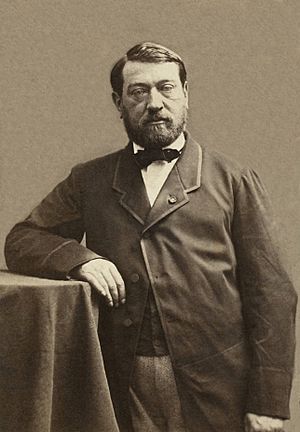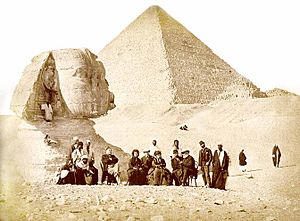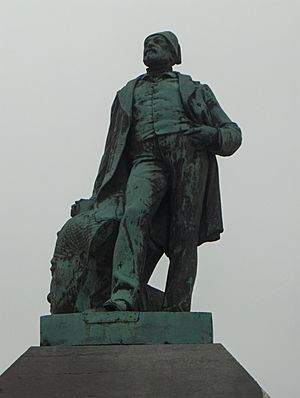Auguste Mariette facts for kids
Quick facts for kids
Auguste Mariette
|
|
|---|---|

Auguste Mariette. Photo by Nadar, c. 1861
|
|
| Born |
François Auguste Ferdinand Mariette
11 February 1821 |
| Died | 18 January 1881 (aged 59) Cairo, Egypt
|
| Nationality | French |
| Occupation | Egyptologist |
François Auguste Ferdinand Mariette (born February 11, 1821 – died January 18, 1881) was a famous French scholar and Egyptologist. He was a key figure in discovering ancient Egyptian treasures. He also founded the Egyptian Department of Antiquities, which helped protect Egypt's historical sites. This department later became the Supreme Council of Antiquities.
Contents
Becoming an Egyptologist
Auguste Mariette was born in Boulogne-sur-Mer, a town in France. His father worked as a town clerk. Auguste went to college in Boulogne, where he was very good at art.
In 1839, when he was 18, he moved to England. He taught French and drawing at a boys' school. He later worked as a designer for a ribbon company. In 1841, he earned a degree from the University of Douai. Mariette was a talented artist and writer. He gave private lessons and wrote about history and archaeology for local magazines.
His cousin, Nestor L'Hôte, was a friend of the famous Egyptologist Jean-François Champollion. When Nestor died, Mariette had to sort through his papers. This made Mariette very interested in Egyptology, the study of ancient Egypt. He taught himself to read hieroglyphs and study the Coptic language. In 1849, his detailed book about the Egyptian collection at the Boulogne Museum helped him get a job at the famous Louvre Museum in Paris.
In 1869, he became a member of the American Philosophical Society, a group that promotes useful knowledge.
First Journey to Egypt

In 1850, the French government sent Mariette to Egypt. His main job was to find and buy old manuscripts (handwritten books) for the Louvre Museum. They wanted to make sure the Louvre had the best collection of Coptic, Syriac, Arabic, and Ethiopic writings.
Mariette didn't have much luck finding manuscripts at first. To avoid returning to France empty-handed, he decided to explore temples. He became friends with a Bedouin tribe, who led him to Saqqara. This area looked like "mounds of sand" at first. But Mariette noticed a sphinx head sticking out of the sand. This sphinx was part of a long path of sphinxes that led to the ruins of the Serapeum of Saqqara. This temple was near the step-pyramid.
In 1851, Mariette hired 30 workers. He made an amazing discovery: the path of sphinxes and a huge underground tomb complex. This complex had catacombs (underground tunnels) with giant stone sarcophagi for the Apis bulls. On November 12, he broke through the entrance and found thousands of statues, bronze tablets, and other treasures. He also found the almost untouched tomb of Prince Khaemweset, a son of Ramesses II.
Other archaeologists and Egyptian officials accused Mariette of stealing. To protect his finds, Mariette started burying them in the desert. The French government then gave him money to continue his excavations. He stayed in Egypt for four years, digging up treasures and sending them to the Louvre. The French government and the Louvre agreed to split the finds: half went to the Louvre, and half stayed in Egypt. When Mariette returned to Paris, 230 crates went to the Louvre, and he was promoted.
Leading Egyptian Antiquities

After his amazing discoveries at Saqqara, Mariette knew he had to return to Egypt. He said he would "die or go mad" if he didn't. Less than a year later, the Egyptian government asked him to come back. In 1858, they created a special job for him: Conservator of Egyptian monuments.
Mariette moved his family to Cairo. His career took off with many successful explorations:
- He got government money to open the Egyptian Museum in Cairo in 1863. This museum helped protect ancient artifacts and stop illegal trading.
- He explored the pyramid areas of Memphis and the tombs of Saqqara. He found many painted wooden statues, like the famous the Seated Scribe.
- He excavated ancient burial sites at Meidum, Abydos, and Thebes.
- He uncovered the large temples of Dendera and Edfu.
- He led important excavations at Karnak, Medinet-Habu, and Deir el-Bahri. At Karnak, he was one of the first to use modern archaeological methods, like carefully digging layer by layer and photographing every object.
- He explored Tanis, an ancient Egyptian capital in the Delta region.
- He even explored Gebel Barkal in Sudan.
- He cleared the sand around the Sphinx and discovered the "Temple of the Sphinx" nearby.
In 1860 alone, Mariette started 35 new dig sites. He also worked to protect sites that had already been dug. At the time, no other groups were allowed to dig in Egypt. This made some British and German archaeologists upset. Mariette also had to deal with the Khedive (the ruler of Egypt). The Khedive believed all discoveries were his property. In 1859, Mariette even had to rush to Thebes to stop a boatload of ancient items from being sent to the Khedive.
Mariette worked hard to control who could work in the Antiquities Service. He wanted to make sure that French influence remained strong in Egyptology.
In 1867, Mariette went back to France to oversee the ancient Egyptian display at a big world fair called the Exposition Universelle. He was celebrated for keeping France at the forefront of Egyptology.
In 1869, the Khedive asked Mariette to write a short story for an opera. This idea was then turned into a full story by Camille du Locle and given to the famous composer Giuseppe Verdi. Verdi agreed to create the opera, which became Aida. Mariette and Du Locle helped design the sets and costumes for Aida, making sure they looked like ancient Egypt. The opera was a huge success when it premiered in 1871.
Mariette received many honors, including being made a bey and then a pasha. He also received awards from European countries.
In 1878, his museum was damaged by floods, which destroyed many of his notes and drawings. By 1881, Mariette was getting old and almost blind. He made sure that another Frenchman, Gaston Maspero, was chosen to take over his role. This helped ensure that France continued to lead Egyptology in Egypt.
Death and Legacy
Auguste Mariette died in Cairo. He was buried in a sarcophagus that is now on display in the garden of the Egyptian Museum in Cairo.
Busts (sculptures of heads and shoulders) of other famous Egyptologists, like Charles Wycliffe Goodwin, are placed around his sarcophagus as a memorial.
Selected Writings
Mariette wrote many books and reports about his discoveries. Here are a few examples:
- Mariette, Auguste. 1857. (Le) Sérapéum de Memphis. Paris: Gide.
- Mariette, Auguste. 1875. Karnak: étude topographique et archéologique... Leipzig: J.C. Hinrichs.
- Mariette, Auguste. 1880. Catalogue général des monuments d'Abydos... Paris: L'imprimerie nationale.
- Mariette, Auguste. 1890. The monuments of Upper Egypt. Boston: H. Mansfield & J.W. Dearborn.
See also
 In Spanish: Auguste Mariette para niños
In Spanish: Auguste Mariette para niños
- Suez Canal Company

